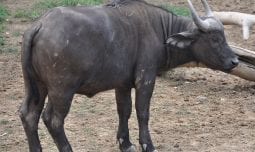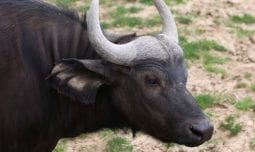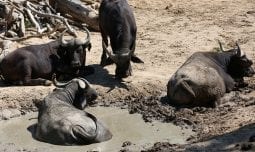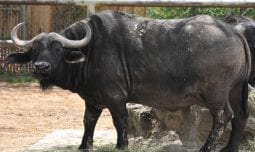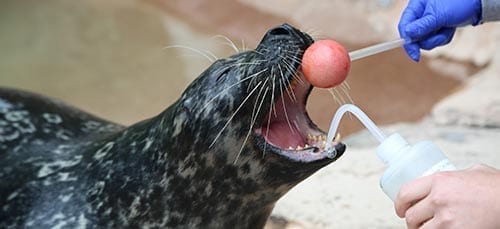Classification
Class Mammalia
Order Artiodactyla
Family Bovidae
Genus Syncerus
Species caffer
Habitat & Range
Open savannas and grasslands near permanent water sources in eastern and southern Africa.
The Cape buffalo’s range is throughout Sub-Saharan Africa.

Cape Buffalo
Syncerus caffer
Both males and females have impressive horns that spread outward then down around the head, and curve back up. The horns are an excellent indication of age and gender. In large adult males the horns are joined in the middle by a hard shield called a “boss” that covers the entire top of the head. The horns are used for defense against predators as well as to determine dominance for mating rights.
Adaptations
Oxpecker Cleaning Service
Cape buffalo are often pictured with birds such as oxpeckers on their backs. The buffalo may be infested with lice, ticks, fleas and other parasites that the birds pick off and eat. The birds get an easy meal and the buffalo get cleaned. The birds also warn the buffalo of approaching danger.
Safety in Numbers
Living in groups provides some protection to herd animals against predators. In some instances Cape buffalo cooperatively mob a predator, such as a lion. Herd members use vocalizations to coordinate group movement and to warn of danger. Members of a herd stay in direct contact with their subgroup members even within a larger group. Herd members will often sleep with their heads resting on one another.
Head Ornaments
Both males and females have impressive horns that spread outward then down around the head, and curve back up. The horns are an excellent indication of age and sex. In large adult males the horns are joined in the middle by a hard shield called a “boss” that covers the entire top of the head. The horns are used for defense against predators as well as to determine dominance for mating rights.
Physical Description
- Males can reach seven to 11 feet (2.1-3.4 meters) long, weigh nearly 2,000 pounds (907 kg), and stand three to five feet (1-1.7 meters) at the shoulder.
- Females are smaller than males.
- Cape buffalo have dark brown to black fur.
- Both males and females have large curved horns.
- Have drooping, fringed ears.
Diet
What Does It Eat?
In the wild: Coarse grasses, leaves, herbs and foliage.
At the zoo: Hay and vitamin supplements.
What Eats It?
Large crocodiles and packs of lions prey on adult buffalo; lions, hyenas and leopards attack young, old or sick buffalo.
Social Organization
Cape buffalo are non-territorial and extremely sociable animals. They live in herds consisting of a dozen or more related cows and their offspring from the past two birthing seasons, accompanied by four or five breeding bulls. Each herd has a “pathfinder” that leads the way to pasture and water. When food is plentiful, the herds gather in large herds of up to 2,000 buffalo.
Life Cycle
Breeding is seasonal. Cows have their first calves when they are about five years old. Bulls are mature at about eight years. Gestation is about 340 days - the longest gestation period in the bovine family. Females give birth to a single calf weighing 50-90 pounds (23-40 kg). Calves are up on their feet within 10 minutes after birth and can follow their mothers after several hours. The calves need several weeks to keep up with the herd. Females remain with their herd but adolescent males leave the herd at about three years forming a subgroup that stays with the larger herd. Old bulls past their prime leave the breeding herds and associate in bachelor groups, of 4-5. Cape buffalo can live 15-25 years in the absence of disease.
Fun Facts
- The Cape buffalo is Africa’s only cow-like mammal.
- Cape buffalo can run up to 37 mph.
- Cape buffalos have a reputation of being dangerous when injured or cornered – they will turn and charge at attacking lions, leopards or hyenas as well as human hunters.
- One of the “Big Five” African animals along with the elephant, rhinoceros, lion and leopard.
Conservation Status
IUCN Status: Lower Risk-Conservation Dependent
Cape buffalo are not currently endangered but the introduction of non-native species such as goats and cattle compete with the buffalo for food and can carry diseases that threaten buffalo. Habitat loss due to increasing human populations is also reducing the available land for Cape buffalo.

Download the App!
Get the FREE Denver Zoo app today, and be a pro the next time you visit the Zoo. You’ll get access to the Zoo map, daily activities and schedules, animal facts, and more. You can even load your membership card onto the app for additional convenience. It puts everything you need for an amazing Zoo experience right into the palm of your hand!

